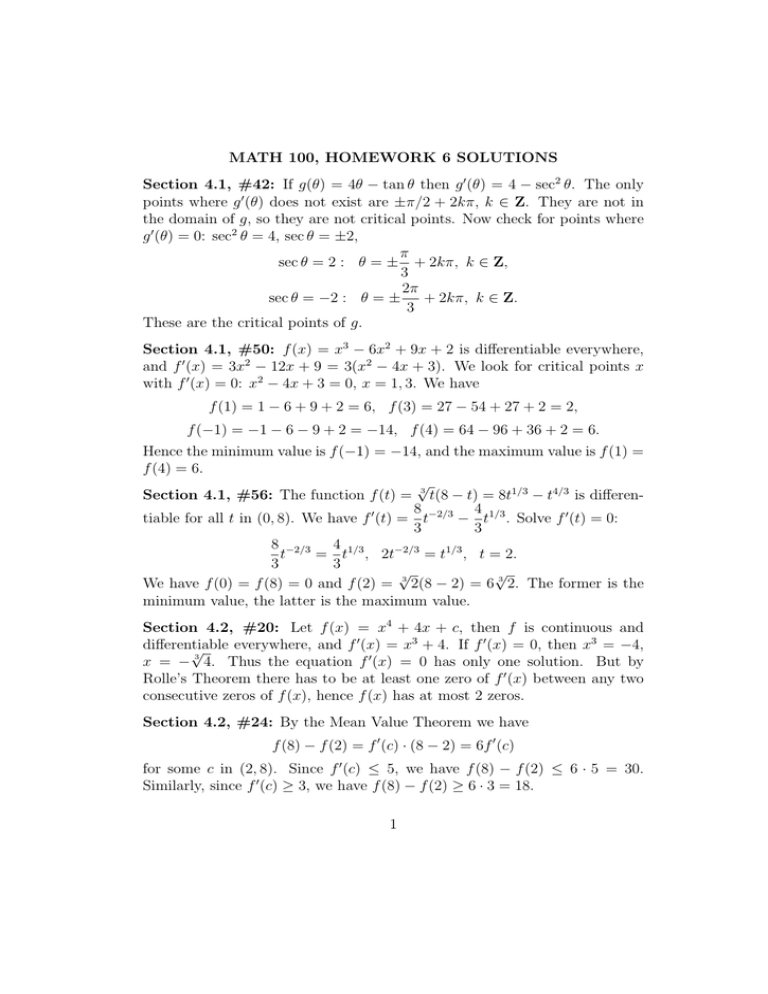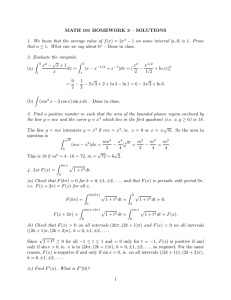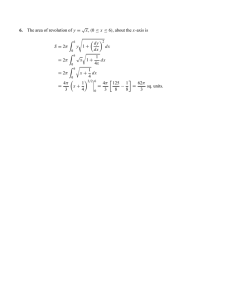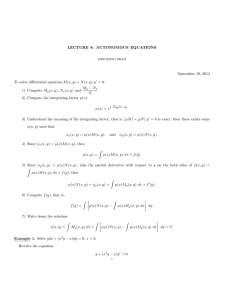MATH 100, HOMEWORK 6 SOLUTIONS (θ) = 4 − sec
advertisement

MATH 100, HOMEWORK 6 SOLUTIONS Section 4.1, #42: If g(θ) = 4θ − tan θ then g 0 (θ) = 4 − sec2 θ. The only points where g 0 (θ) does not exist are ±π/2 + 2kπ, k ∈ Z. They are not in the domain of g, so they are not critical points. Now check for points where g 0 (θ) = 0: sec2 θ = 4, sec θ = ±2, π sec θ = 2 : θ = ± + 2kπ, k ∈ Z, 3 2π sec θ = −2 : θ = ± + 2kπ, k ∈ Z. 3 These are the critical points of g. Section 4.1, #50: f (x) = x3 − 6x2 + 9x + 2 is differentiable everywhere, and f 0 (x) = 3x2 − 12x + 9 = 3(x2 − 4x + 3). We look for critical points x with f 0 (x) = 0: x2 − 4x + 3 = 0, x = 1, 3. We have f (1) = 1 − 6 + 9 + 2 = 6, f (3) = 27 − 54 + 27 + 2 = 2, f (−1) = −1 − 6 − 9 + 2 = −14, f (4) = 64 − 96 + 36 + 2 = 6. Hence the minimum value is f (−1) = −14, and the maximum value is f (1) = f (4) = 6. √ Section 4.1, #56: The function f (t) = 3 t(8 − t) = 8t1/3 − t4/3 is differen4 8 tiable for all t in (0, 8). We have f 0 (t) = t−2/3 − t1/3 . Solve f 0 (t) = 0: 3 3 8 −2/3 4 1/3 t = t , 2t−2/3 = t1/3 , t = 2. 3 3 √ √ We have f (0) = f (8) = 0 and f (2) = 3 2(8 − 2) = 6 3 2. The former is the minimum value, the latter is the maximum value. Section 4.2, #20: Let f (x) = x4 + 4x + c, then f is continuous and differentiable everywhere, and f 0 (x) = x3 + 4. If f 0 (x) = 0, then x3 = −4, √ 3 x = − 4. Thus the equation f 0 (x) = 0 has only one solution. But by Rolle’s Theorem there has to be at least one zero of f 0 (x) between any two consecutive zeros of f (x), hence f (x) has at most 2 zeros. Section 4.2, #24: By the Mean Value Theorem we have f (8) − f (2) = f 0 (c) · (8 − 2) = 6f 0 (c) for some c in (2, 8). Since f 0 (c) ≤ 5, we have f (8) − f (2) ≤ 6 · 5 = 30. Similarly, since f 0 (c) ≥ 3, we have f (8) − f (2) ≥ 6 · 3 = 18. 1





